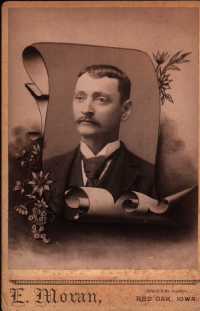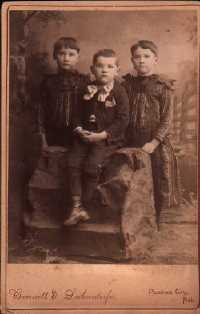Sign up for the Family Tree Newsletter Plus, you’ll receive our 10 Essential Genealogy Research Forms PDF as a special thank you!
Get Your Free Genealogy Forms
"*" indicates required fields
 |
 |
| Figure 1 | Figure 2 |
David Starr found a family album with about 80 photographs in it and could identify only 15. He randomly selected several images and submitted them to this column. His ancestors didn’t take the time to write names on the backs of the images or underneath them in the album, but there are still some ways to identify those images.
It is tempting to remove all the pictures from an album but fight the urge to do so. Why? Well, think about how you arrange your photographs in an album. You probably organize them according to date or by event. The collective arrangement ends up telling a story. When you take apart an ancestral album you are destroying the context of the images to each other. There are clues in each photograph based on their order. Slowly turn each page, looking for a general theme.
- Is it just one family?
- Does the clothing change as the album progresses?
- Are any of the people the same, but in photographs taken at a later/earlier date?
Before examining the album any further, photocopy or scan each page so that you don’t lose the original sequence. Next, gently remove each picture from its place, being careful not to damage the brittle paper and the photograph. Examine it front and back and either scan it or photocopy it before putting it back in its original place. You are looking for identifying information written on the back and a name of a photographer. Research the photographers using city directories or online databases to discover when they were in business. This gives you a general time frame for the album.
In David Starr’s case, several different photographers took the images. Edgar Moran of Red Oak, Iowa, took this photograph (Figure 1) of an unidentified man during 1895-96 while Figure 2 was taken in Pawnee City, Neb., in 1893 by Bennett and Liebendorfer. These two images, taken during the same decade by photographers who operated during a short time frame, help place those photographs within the family context.
Using the identifications or dates for the photographers, compare the data to your genealogy. It may help you answer the first question listed above. Associating an album with one branch of the family can at least provide potential surnames for those unidentified individuals. You can further narrow the possibilities by researching their clothing styles and making a list of ancestors that match the age and location to the pictures. Of course, you are also looking for family resemblance in the pictures and any other clues such as props that appear in the pictures.
There is an unwritten story in each family album waiting for a person with patience to uncover it. Think about each picture as a page in your family story. By working on one image at a time you are slowly bringing a family to life with your research. Don’t forget to share your discoveries with other relatives. Bring them with you to the next family reunion or post them online. Whatever you do, try to show them to as many relatives as possible. You never know who is going to be able to provide names for those unidentified faces. Why not make it a family project? Photographs have a remarkable way of bringing families together. Each person could research one picture, compare notes and discover a whole new family history—illustrated with pictures.
Find out how to submit your own picture for possible analysis by Maureen Taylor. E-mail her at mtaylor@taylorandstrong.com.
ADVERTISEMENT

